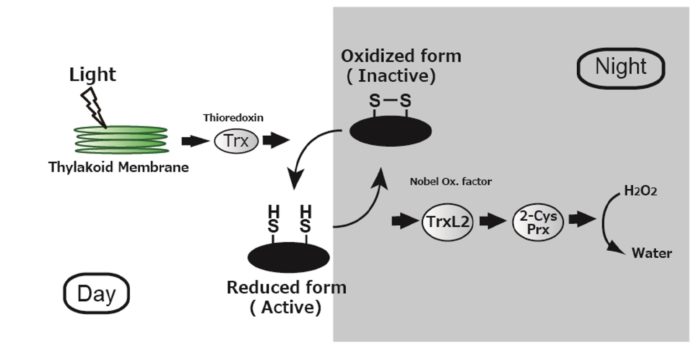Photosynthesis is a process used by plants in which energy from sunlight is used to convert carbon dioxide and water into molecules needed for growth. Plants generate food through this process.
The proteins engaged with photosynthesis should be ‘on’ when they have the sunlight while working, however, need to be idle, similar to the motor of an auto at a movement light, oblivious, when photosynthesis isn’t conceivable. They do this by a procedure called ‘redox regulation’— the activation and deactivation of proteins by means of changes in their redox (decrease/oxidation) states.

Arabidopsis leaves (left), Epidermal cells (center, bar=20 μm) and schematic of chloroplasts (right). Chloroplasts, size from 3 to 10 μm, photosynthetic cell organelles in green leaves, capture light energy and use it to produce energy-rich molecules and to generate oxygen. They split water and use the electrons from these molecules on the process.
What occurs in light is surely known: the ferredoxin-thioredoxin reductase (FTR)/thioredoxin (Trx) pathway is in charge of the lessening procedure, which initiates the photosynthetic pathway. Be that as it may, researchers have for some time been oblivious to what happens when the light isn’t accessible, and how plants reset photosynthetic proteins to be prepared to work when the light is resumed.
Now, scientists at the Tokyo Tech have recognized two proteins that enable plants to respond to changes in encompassing light conditions and in this manner make photosynthesis more proficient.
The proteins contained the thioredoxin-like2 (TrxL2)/2-Cys peroxiredoxin (2CP) redox cascade, that helps control the reoxidation of these photosynthetic proteins by modifying key parts of the molecular players.
These two proteins seem to work as a component of a cascade that siphons energy from the photosynthetic proteins to the always energy-hungry hydrogen peroxide. TrxL2, dissimilar to comparable, better-known proteins, is by all accounts particular for the ‘switching off’ process; it’s a productive oxidizer of numerous proteins, however just decreases 2CP, permitting the energy drained by TrxL2 out of a from upstream responses to go to 2CP and thereupon hydrogen peroxide. This cascade keeps photosynthesis on backup until the point when the light is accessible again.
TrxL2/2CP do work in light also, however, are dominated by the normal activation machinery in plants and just become the dominant center without light. Curiously, this course does not appear to influence photosynthesis itself, as mutant plants without 2CP carry on typically in light; nonetheless, the ‘switching off’ system is fundamentally less proficient in these mutant plants than in wild-type plants.
Besides, the way that this procedure is less proficient, as opposed to truant out and out, proposes that other, up ’til now obscure, proteins serve comparative capacities in plants. These specialists, therefore, shed light on how plants hold the action of photosynthetic proteins for when it’s really helpful.
The study is published in the journal PNAS.
